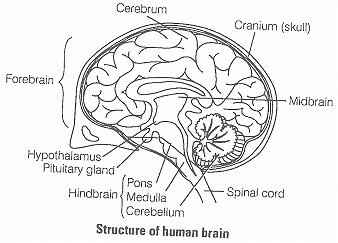30. Name the parts of human forebrain indicating their respective functions.
The forebrain is the largest part of the brain most of which is cerebrum. Other important structures include the thalamus, hypothalamus andthe limbic system.
The cerebrum is divided into two cerebral hemisphere connected here by a mass of white matter known is corpus callosum. Each hemispere is split into four lobes. The surface of each hemisphere is made up of grey matter known asthe cerebral cortex thatis folded to increase the surface area. Various structures of forebrain are given below
|
Brain Region |
Structure |
Function |
|
Diencephalon Diencephalon Diencephalon Telencephalon Telencephalon Telencephalon |
Thalamus Hypothalamus Pituitary Cerebral cortex Limbic system Olfactory bulb /lobes |
Organising sensory information Endocrine system, thermoregulation Endocrine system Consciousness, language, etc Memory, motivation, emotions Smell |
Thalamus
The thalamus has many functions including processing and relaying sensory information selectively to various parts of the cerebral cortex, translating signals to the cerebral cortex and also regulating states of sleep and wakefulness. The thalamus plays a major role in regulating arousal levels of consciousness and levels of activity.
Hypothalamus
The function of the hypothalamus is mainly related to the overall regulation of the endocrine system and closely related to the pituitary gland.
Pituitary
The function of the pituitary is mainly related to the production of hormones as part of the endocrine system.
Cerebral Cortex
The cerebral cortex is essential for memory, aitention, awareness, thought, language and consciousness. The cerebral cortex is connected to structures such as the thalamus and the basal ganglia, sending information to them along efferent connections and receiving information form them via afferent connections.
Motor Cortex
The motor cortex areas of the brain are located in both hemispheres of the cortex are related to controlling voluntary movements, especially fine movements.
Sensory Areas
The sensory areas are the areas theat receive and process information from the senses. inputs form the thalamus are called primary sensory areas, where vision, hearing and touch are processed. The two hemispheres of the cerebral cortex receive information form the opposite (contra lateral) side of the body.
The association areas of the brain function to produce a perception of the world enabling an animal to interact environment effectively. The frontal lobe or prefrontal association complex is involved in planning actions and movement.
Limbic System
The limbic system is principally responsible for emotions and the various types of emotion can effect the activity of the Autonomic Nervous System (ANS) facilitated by the hypothalamus.
Olfactory Bulb
The olfactory bulb is responsible for olfaction concerned with sense of small plays.
